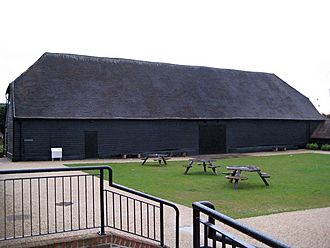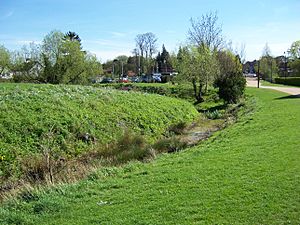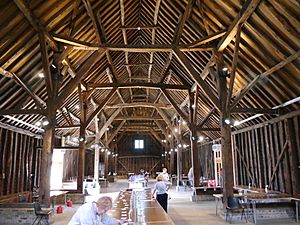Manor Farm, Ruislip facts for kids
Quick facts for kids Manor Farm |
|
|---|---|

The Great Barn, built around 1280
|
|
| General information | |
| Classification | Grade II and II* listed buildings |
| Location | Ruislip |
| Town or city | Greater London |
| Country | England |
| Coordinates | 51°34′42″N 0°25′42″W / 51.578206°N 0.428451°W |
| Completed | 13th century |
Manor Farm is a historic site in Ruislip, Greater London, covering about 22-acre (8.9 ha). It has an old farm complex from the Middle Ages. The main barn, called the Great Barn, was built in the 13th century. The farm house is from the 16th century.
Close by are the remains of a motte-and-bailey castle. This type of castle was built shortly after the Norman conquest of England. Some parts of the site show groundwork from as far back as the 9th century.
In the 15th century, King's College, Cambridge took ownership of the site. In 1930, experts saw that the Great Barn and Little Barn needed to be saved. In 1931, Manor Farm was given to the people of Ruislip. It continued as a working farm until 1933. Today, the London Borough of Hillingdon runs it as a community place.
Manor Farm was restored in 2007 and 2008 with money from the National Lottery. It is now an important heritage area. The site is part of the Ruislip Village Conservation Area. Many events are held in the 13th-century Great Barn and around the farm.
Contents
History of Manor Farm
Ancient Origins
You can still see parts of the old motte-and-bailey castle today. This includes a moat and a bank. A moat is a deep, wide ditch, often filled with water, that protects a castle. The moat here is a scheduled monument, meaning it's a very important historical site.
It's thought the moat was made bigger to create an oval area. A wooden castle, about 350 foot (110 m) by 200 foot (61 m), was likely built there. This was probably for Ernulf de Hesdin, who was given control of Ruislip after the Norman conquest. He was loyal to William the Conqueror.
The castle was likely built between 1066 and 1087. However, it is not mentioned as a castle in the 1086 Domesday Book. This means it might have been taken down or changed a lot by then. It might even have never been finished.
Monks and Manors
From 1096 to 1404, the Benedictine Bec Abbey from Normandy owned Ruislip. The head of the abbey, called the prior, built a home for himself on the site. This home was surrounded by a moat.
In the 16th century, the old motte-and-bailey site became the gardens for the new Manor Farm House. In 1888, Henry James Ewer, who farmed there, filled in the moat extension. The shape of the moat and signs of a fortified building show this part of the site is from the 11th century.
The farm buildings themselves date back to the 13th century. The Great Barn is the most famous. It is the second largest barn of its kind in Middlesex. The Great Barn was built using English oak wood from the nearby Ruislip Woods. It was designed as an "aisled barn." This means it has smaller sections running along the main supports, all under one big roof.
Who Owned the Farm?
Studies by English Heritage show that Manor Farm was once a working farm. It also served as the manorial court hall for Ruislip. A manorial court was where local rules were made and small disputes were settled.
The main farm house was built over two older structures. This was likely done for Robert Drury, who was renting the manor. He was a former Speaker of the House of Commons, a very important job in the government. Skilled builders and carpenters likely did the work. Manor Farm was also known as Ruislip Court until the 19th century.
In 1451, ownership of the farm, along with the rest of Ruislip, went to King's College, Cambridge. They are still the official Lords of the Manor today. King's College did two surveys of the manor in 1565 and 1750.
The Farm House was built in the 16th century using local bricks, tiles, and timber. It was used for the manorial court until 1925. In the 18th and 19th centuries, the windows and doorways were replaced. An extended kitchen was also added.
Saving Manor Farm
In the early 1900s, Manor Farm and Park Wood were almost destroyed. There were plans to build many new homes. A town planning competition was held, and a design for over 7,600 new homes was chosen. If this plan had gone through, St. Martin's Church would have been the only old building left in Ruislip.
Building work started on a few roads before the First World War. But the war stopped everything. After the war, the plan was much smaller, and work slowed down.
In January 1930, a member of the Royal Society of Arts visited Ruislip. They chose buildings that should be saved. The Great Barn and Little Barn were chosen. Other old buildings like the Post Office and a local pub were also selected.
The local woods, along with Manor Farm, were saved when King's College sold the land in February 1931. Park Wood was sold, and Manor Farm was given as a gift to the people of Ruislip. The local council agreed to look after the wood and make sure no new buildings were put up without permission.
In 1932, two old cart sheds at the farm entrance were removed. Manor Farm continued as a working farm until 1933. Then, the local council started selling off much of the land around the buildings for new houses. A piece of land was given to the Ruislip Village Trust for a public hall. The Winston Churchill Hall was built there in 1965.
The Little Barn, built in the 16th century, was turned into a library. It opened on 2 November 1937. The original cowbyre, a place for cows, burned down in 1979. It was rebuilt as an exhibition centre. In 1997, archaeologists found remains of the old priory under the Farm House.
Modern Restoration
Manor Farm was renovated between April 2007 and June 2008. This was possible thanks to money from the Heritage Lottery Fund. The Grade II listed Manor Farm library was also updated.
The Duck Pond Market started in the Great Barn in December 2008, after the renovations. It runs twice a month. The Winston Churchill Theatre also received money for its own updates in 2011.
Today, the buildings on the site are used for many things. The Cow Byre Gallery is an exhibition space. The Stables and the Manor Farm Community Hut are community spaces. The Manor Farm House is a small information centre and home to the Hillingdon Music Service.
Since 1974, all the buildings at Manor Farm have been listed as historic buildings. Most are Grade II listed, but the Great Barn is even more important, listed as Grade II*.
Images for kids










